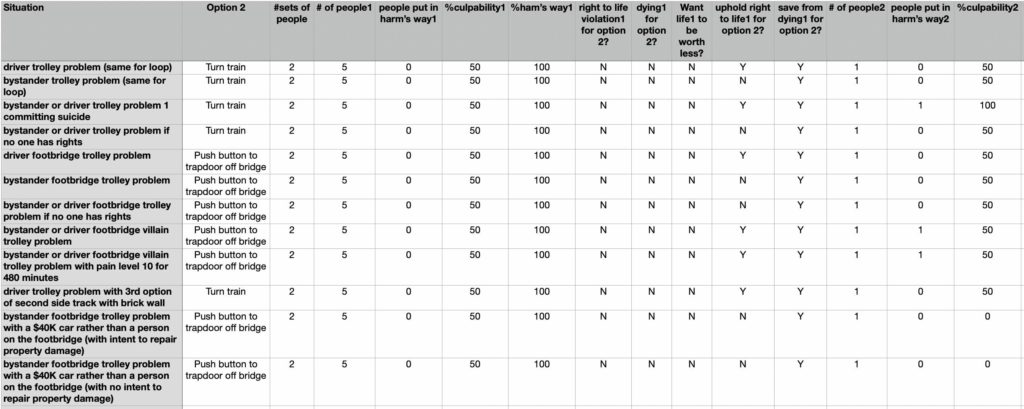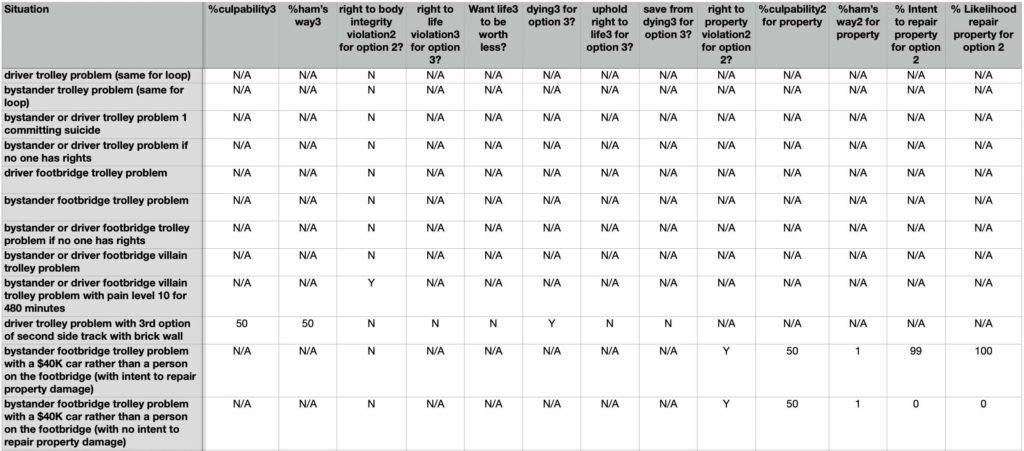Dec. 8, 2023
Example Ethical Dilemma Calculations
The most ethical decision option was calculated using EthicsCalcDemoCode.ipynb for a few “ethical dilemmas” (see Foot 1967, Thomson 1976, 1985, 2008):
- Driver trolley problem (with or without loop) – runaway trolley would hit and kill 5 workers on the main track, or the trolley driver could turn the trolley onto a side track and kill 1 worker, which would, if there were a loop back to the main track before the train would continue towards the 5 workers, stop the train
- Bystander trolley problem (with or without loop) – runaway trolley would hit and kill 5 workers on the main track, or a bystander could turn the trolley onto a side track and kill 1 worker, which would, if there were a loop back to the main track before the train would continue towards the 5 workers, stop the train
- Bystander (or driver) trolley problem with person on side track committing suicide – runaway trolley would hit and kill 5 workers on the main track, or a bystander could turn the trolley onto a side track and kill 1 worker who has made it clear they are there to commit suicide by being hit by a trolley
- Bystander (or driver) trolley problem if no one has rights – runaway trolley would hit and kill 5 workers on the main track, or the trolley driver could turn the trolley onto a side track and kill 1 worker, with all workers assumed to have no rights
- Driver footbridge trolley problem – runaway trolley would hit and kill 5 workers on the main track, or the trolley driver could activate a hidden trap door on a footbridge above the main track, to drop someone onto the track, killing them and stopping the trolley before it hit the 5 workers on the main track
- Bystander footbridge trolley problem – runaway trolley would hit and kill 5 workers on the main track, or a bystander could activate a hidden trap door on a footbridge above the main track, to drop someone onto the track, killing them and stopping the trolley before it hit the 5 workers on the main track
- Bystander footbridge trolley problem if no one has rights – runaway trolley would hit and kill 5 workers on the main track, or a bystander could activate a hidden trap door on a footbridge above the main track, to drop someone onto the track, killing them and stopping the trolley before it hit the 5 workers on the main track; all involved considered to have no rights
- Bystander (or driver) footbridge villain trolley problem – runaway trolley would hit and kill 5 workers on the main track, or a bystander could activate a hidden trap door on a footbridge above the main track, to drop someone onto the track, killing them and stopping the trolley before it hit the 5 workers on the main track. That “someone” is a “villain” who tied the 5 workers to the main track.
- Bystander (or driver) footbridge villain trolley problem with pain level 10 for 480 minutes – runaway trolley would hit and kill 5 workers on the main track, or a bystander could activate a hidden trap door on a footbridge above the main track, to drop someone onto the track, stopping the trolley before it hit the 5 workers on the main track, but somehow subjecting that someone to a pain level of 10 for 480 minutes (8 hours). That “someone” is a “villain” who tied the 5 workers to the main track.
- Driver trolley problem with third option of second side track with brick wall – runaway trolley would hit and kill 5 workers on the main track, or the trolley driver could turn the trolley onto a side track and kill 1 worker, or the trolley driver could turn the trolley onto a second side track where there’s a brick wall, thus resulting in the driver’s death
- Bystander footbridge trolley problem with a $40K car rather than a person on the footbridge – runaway trolley would hit and kill 5 workers on the main track, or a bystander could activate a hidden trap door on a footbridge above the main track, to drop a car worth $40K onto the track, destroying the car and stopping the trolley before it hit the 5 workers on the main track. There is intent to repair 99% of the property damage to the car later.
- Bystander footbridge trolley problem with a $40K car rather than a person on the footbridge – runaway trolley would hit and kill 5 workers on the main track, or a bystander could activate a hidden trap door on a footbridge above the main track, to drop a car worth $40K onto the track, destroying the car and stopping the trolley before it hit the 5 workers on the main track. There is no intent to repair the property damage to the car later.
In these calculations, “person#1” corresponds to 5 people on the main track and “person#2” to 1 person either on a side track or a footbridge above the main track. Some other aspects of the situations/calculation inputs include:
- All potential rights violations are considered actual, not threatened, i.e., no one is threatening to make the trolley brakes malfunction, they’ve already malfunctioned.
- No one has made clear that they want their life to be worth less than others’ lives, except the person committing suicide in the third case above.
- No one waives consideration of their value loss or gain in the situation (other than the person committing suicide in the third case above making it clear they want their life to be worth less).
- Except in the last case, no one has intent to repair damages later (it isn’t possible to truly repair damages in these cases anyway since you can’t undo right to life violations or deaths).
- No property damage to the trolley or right to body integrity violations are considered, i.e., the trolley and the track are taken to be undamaged in all cases, and people who are hit by the trolley are assumed to die instantly.
- Effects on people’s consciences are not directly considered in these calculations
- All people on the track and footbridge (other than the “bystander”) are assumed to be identical in age, income, etc., i.e., they’re all assumed to have the same life value, which, in the program, is the “default” life value.
- When a “villain” is present who’s put people in harm’s way, the situation for the bystander changes. Without a villain present, if the bystander saves the people in harm’s way, they aren’t considered to uphold those people’s rights. With a villain present, if the bystander violates the villain’s rights to save the people in harm’s way, they’re effectively upholding those people’s rights by acting in self-defense on their behalf against the villain.
The results of these calculations are shown in Table I below.
Table I. Calculated most ethical option, and calculated net value change for option 2 (turning the trolley/train, or activating trap door) and option 3 (where applicable) with respect to option 1 (doing nothing).

Table I (continued).

Table I (continued).

References:
Foot, P., “The Problem of Abortion and the Doctrine of Double Effect”, Oxford Review, 5: 5–15 (1967). Reprinted in Virtues and Vices and Other Essays in Moral Philosophy, 19–32 (1978).
Thomson, J.J., “Killing, Letting Die, and the Trolley Problem,” Monist (1976) 59: 204-17.
Thomson, J.J., “The Trolley Problem,” The Yale Law Journal, 94 (6): 1395-1415 (1985).
Thomson, J.J., “Turning the Trolley,” Philosophy & Public Affairs, 36 (4): 359-74 (2008).